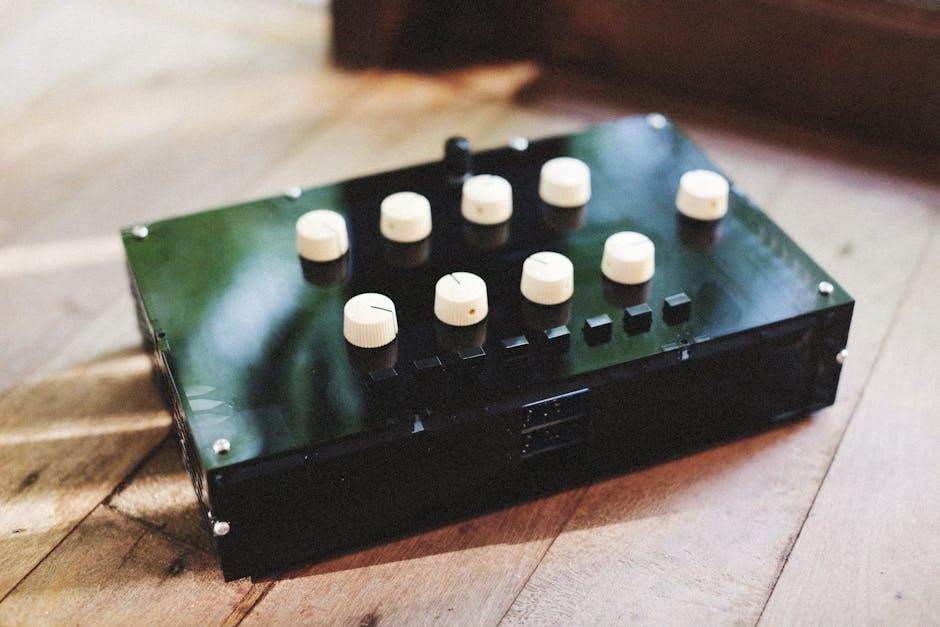emerson controller manual

Emerson Controller Manual: A Comprehensive Guide
Welcome to the comprehensive guide for Emerson Controller Manuals! This resource will help you navigate the intricacies of Emerson controllers, ensuring you can effectively operate and maintain your systems.
Emerson controllers are integral components in various industrial and commercial applications, providing precise control and monitoring of critical processes. These controllers are designed to optimize performance, enhance energy efficiency, and ensure the safety of operations. This guide serves as an introduction to understanding Emerson controllers, their functions, and the importance of utilizing the correct manuals for operation and maintenance.
Understanding the specific model and its corresponding manual is crucial for effective troubleshooting and configuration. Emerson offers a wide range of controllers, each tailored to specific applications. This section provides a foundational overview to help you identify the right resources and maximize the benefits of your Emerson controller.

Understanding Emerson Controller Basics
This section provides a foundational overview of Emerson controllers. It will cover essential concepts, terminology, and general functions. This information is crucial for effectively using the controller manuals.
What is an Emerson Controller?
An Emerson controller is a sophisticated device designed to manage and optimize various industrial processes and systems. These controllers often integrate with equipment like compressors and HVAC systems, providing precise control over parameters such as temperature, pressure, and flow. Emerson controllers are integral to maintaining operational efficiency and safety across diverse applications.
These controllers utilize advanced algorithms and feedback mechanisms to ensure optimal performance. They come equipped with features like error code diagnostics, manual reset options, and programmable settings. Emerson controllers are found in energy systems, climate control, and industrial automation, and they are essential to modern operations. With proper configuration, they will provide years of reliable service.
Types of Emerson Controllers
Emerson offers a wide array of controllers tailored to different applications. These include controllers designed for HVAC systems, refrigeration units, and industrial automation processes. Some examples include the Millennium RM2-ARD Rack Mount Dual Channel Controller and the EXD-TEVI controller for enhanced wet vapor injection. These vary in functionality and application from simple on/off control to complex, automated control.
Each type caters to specific needs, such as managing compressor operations, controlling electric expansion valves, or providing network power solutions. Understanding the specific type of controller is vital for proper installation, configuration, and troubleshooting. The documentation will provide information.

Locating the Correct Emerson Controller Manual
Finding the right manual is crucial. This section guides you through identifying your controller model, using Emerson’s online portal, and searching by part number to access specific documentation.
Identifying Your Emerson Controller Model
To locate the correct Emerson controller manual, begin by accurately identifying your controller model. This is typically found on a nameplate affixed to the device itself. Look for a series of alphanumeric characters, such as “EUC-100-GENERIC” or “BMK 588 903/1”, which uniquely identifies your specific model.
The nameplate may also include other relevant information like the manufacturing date, serial number, and electrical specifications. Note down the complete model number as this will be essential for searching Emerson’s online documentation portal or contacting technical support. Incorrect model identification can lead to using the wrong manual, potentially causing configuration errors or system damage;
If the nameplate is damaged or illegible, consult your system’s documentation or contact Emerson’s technical support for assistance in identifying the controller model.
Using Emerson’s Online Documentation Portal
Emerson provides an extensive online documentation portal to access a wide range of manuals and technical resources for their controllers. To effectively use this portal, navigate to Emerson’s official website and locate the “Documentation” or “Support” section. Here, you’ll typically find a search function specifically designed for finding product manuals.
Enter the complete model number you identified earlier into the search bar. The portal should then display a list of relevant documents, including user manuals, installation guides, and technical specifications. Be sure to filter or refine your search if necessary to pinpoint the exact manual for your controller. You can also browse by product category or series if you are unsure of the exact model number.
The portal often provides the latest versions of the manuals in PDF format, allowing you to download and save them for offline access.
Searching for Specific Manuals by Part Number
If you have the part number of your Emerson controller, this method offers a precise way to locate the corresponding manual. Part numbers are typically found on the controller itself, often on a label or nameplate affixed to the device. Once you have the part number, visit Emerson’s online documentation portal or support website.
Use the search function and enter the complete part number. The system should directly return the manual or a list of documents associated with that specific part. This method eliminates ambiguity and ensures you access the correct documentation for your controller.
If the initial search yields no results, try variations of the part number or consult Emerson’s technical support for assistance. Accurate part numbers are crucial for efficient manual retrieval.

Key Features and Functions Explained in Emerson Controller Manuals
Emerson controller manuals detail crucial features like controller settings, error code troubleshooting, and reset procedures. Understanding these aspects is essential for optimal controller operation and maintenance.
Controller Settings and Configuration
Emerson controller manuals provide thorough guidance on controller settings and configuration, crucial for optimizing system performance. These manuals detail how to adjust parameters to meet specific operational needs, enhancing efficiency and reliability. Proper configuration ensures the controller functions as intended, preventing potential issues and maximizing output. The manuals cover various settings, including temperature thresholds, pressure limits, and control algorithms.
Furthermore, they explain how to navigate the controller’s interface to modify these settings accurately. Detailed diagrams and step-by-step instructions make the configuration process straightforward, even for users with limited experience. Understanding these settings allows for precise control and fine-tuning of the system, leading to improved overall performance and reduced energy consumption. Proper configuration also aids in preventing equipment damage and extending the lifespan of the controlled components;

Understanding Error Codes and Troubleshooting
Emerson controller manuals are essential for understanding error codes and troubleshooting system malfunctions. These manuals provide a comprehensive list of error codes, each linked to a specific problem within the controlled system. They offer detailed explanations of what each code signifies, enabling users to quickly identify the root cause of an issue.
Troubleshooting sections within the manuals guide users through step-by-step diagnostic procedures to resolve problems effectively. These procedures often include checking sensor readings, verifying wiring connections, and testing component functionality. The manuals also suggest possible solutions and corrective actions for each error code, minimizing downtime and facilitating efficient repairs. Understanding these codes and troubleshooting steps is critical for maintaining system reliability and preventing further damage. Furthermore, the manuals often include diagrams and illustrations to aid in the troubleshooting process, making it easier to identify and resolve issues promptly.
Manual Reset Procedures
Emerson controller manuals provide detailed instructions on how to perform manual resets, which are often necessary after certain fault conditions. These procedures typically involve pressing a specific button or sequence of buttons on the controller interface, as outlined in the manual. The manual reset clears any latched fault codes and allows the controller to resume normal operation.
It is crucial to understand the conditions under which a manual reset is required, as outlined in the manual. Repeatedly resetting the controller without addressing the underlying issue can lead to further problems or system damage. The manuals also specify any precautions or additional steps that should be taken before performing a reset, such as checking for any obvious mechanical or electrical issues. Following the manual reset procedures accurately is essential for ensuring the safe and effective operation of the Emerson controller.

Safety Information and Precautions
This section outlines crucial safety guidelines and precautions for Emerson controllers. Always consult the manual to ensure safe operation, preventing potential hazards and equipment damage.
General Safety Guidelines
Before operating any Emerson controller, thoroughly read and understand the safety guidelines in the manual. These guidelines are crucial for preventing personal injury and equipment damage. Always ensure the controller is installed and maintained by qualified personnel. Verify that the power supply matches the controller’s specifications to avoid electrical hazards.
Regularly inspect the controller and its wiring for any signs of wear or damage. Replace any damaged components immediately. Never attempt to repair a controller unless you are a trained technician. Ensure that the controller is properly grounded to prevent electrical shock. Keep the controller clean and free from dust and debris to maintain optimal performance. If any unusual odors or noises are detected, disconnect the power supply and contact technical support. Adhering to these general safety guidelines is essential for the safe and reliable operation of Emerson controllers;
Electrical Safety Instructions
When working with Emerson controllers, always prioritize electrical safety. Disconnect the power supply before performing any maintenance or repairs. Use appropriate personal protective equipment (PPE), such as insulated gloves and safety glasses, to prevent electrical shock and injury. Ensure that all wiring connections are secure and properly insulated to avoid short circuits.
Never work on live circuits unless absolutely necessary, and only do so with proper training and precautions. Verify that the controller is properly grounded to prevent electrical hazards. If you are unsure about any electrical procedure, consult a qualified electrician or Emerson technical support. Avoid working in wet or damp environments to minimize the risk of electrical shock. Regularly inspect the controller’s wiring for damage and replace any faulty components immediately. By following these electrical safety instructions, you can ensure a safe working environment when operating and maintaining Emerson controllers.
Environmental Considerations
When operating and maintaining Emerson controllers, it is crucial to consider environmental factors to ensure optimal performance and longevity. Avoid exposing the controller to extreme temperatures, humidity, or corrosive substances, as these conditions can damage internal components and affect functionality. Ensure proper ventilation around the controller to prevent overheating and maintain a stable operating temperature.
Dispose of any replaced components or materials in accordance with local environmental regulations. Recycle whenever possible to minimize waste and promote sustainability. Protect the controller from dust, dirt, and other contaminants that can accumulate and impede performance. Regularly clean the controller’s exterior with a soft, dry cloth to remove any debris. By addressing these environmental considerations, you can extend the lifespan of your Emerson controller and contribute to a more sustainable operation.

Advanced Configuration and Programming
Explore advanced configuration and programming techniques for Emerson controllers, including HOT-KEY programming and parameter customization. Optimize your system’s performance with tailored settings to meet specific application requirements.
Programming via HOT-KEY
The HOT-KEY feature on Emerson controllers provides a convenient method for programming and configuring devices. This tool allows users to quickly transfer settings between controllers, ensuring consistency and reducing setup time. To use HOT-KEY, first, ensure the target controller is compatible and powered on. Connect the HOT-KEY programming keyboard to the designated port on the controller.
Next, navigate to the programming menu and select the desired parameters. Save the settings to the HOT-KEY. Then, connect the HOT-KEY to another compatible controller and upload the saved settings. This process simplifies mass configuration. Always verify the settings after the transfer. Refer to the controller manual for specific HOT-KEY instructions.
Customizing Controller Parameters
Customizing controller parameters is crucial for optimizing performance and adapting to specific application requirements. Emerson controller manuals provide detailed instructions on how to adjust various settings, including temperature ranges, alarm thresholds, and control algorithms. Before making any changes, it’s essential to understand the implications of each parameter and document the original settings for easy restoration if needed.
Access the controller’s configuration menu through the user interface or a connected computer. Navigate to the specific parameter you wish to modify and carefully enter the new value. Always test the system after making changes to ensure the adjustments have the desired effect and do not negatively impact overall operation. Regular monitoring and fine-tuning may be required.

Troubleshooting Common Issues
This section addresses frequently encountered problems with Emerson controllers. Learn to diagnose and resolve issues effectively using the troubleshooting guides in your Emerson controller manual for efficient solutions.
Addressing Lockout Situations
Lockout situations in Emerson controllers can be frustrating, often requiring a manual reset or power cycle. According to available documentation, repeated trips due to protective faults may lead to a lockout, indicated by specific error codes on the controller display, such as “L44”.
The Emerson controller manual provides detailed steps for identifying the cause of the lockout. It is imperative to address the underlying issue, which could range from high discharge temperature to other system faults. The manual also outlines procedures for performing a manual reset, which may involve pressing specific buttons or cycling the power.
Note that some controllers may allow a limited number of automatic resets before requiring a manual intervention. Consult your manual to understand the specific lockout behavior and reset procedure applicable to your Emerson controller model. Ignoring lockout situations may lead to further system complications and potential damage.
Resolving Temperature Control Problems
Emerson controller manuals are essential for diagnosing and resolving temperature control problems. These manuals often provide detailed troubleshooting steps for issues such as temperature fluctuations, inaccurate readings, or failure to maintain setpoints. Understanding the controller’s settings and parameters is crucial for effective temperature management.
Refer to the manual for guidance on checking sensor calibration, verifying wiring connections, and adjusting control parameters. Many Emerson controllers offer features like automatic reset capabilities, which can help address temporary temperature deviations. However, persistent problems may require a manual reset or further investigation.
The manual will also detail error codes related to temperature issues, guiding you to identify specific faults, such as high discharge temperature trips. By consulting the Emerson controller manual, you can systematically address temperature control problems and ensure optimal system performance, and avoid potential damage or inefficiencies.

Maintenance and Calibration
Proper maintenance and calibration are vital for Emerson controllers. Regular checks and adjustments ensure accurate performance and prolong the controller’s lifespan. Consult the manual for specific guidelines and schedules.
Routine Maintenance Procedures
Regular maintenance is crucial for ensuring the longevity and optimal performance of your Emerson controller; Always refer to the specific model’s manual for detailed instructions. Begin with visual inspections, checking for any signs of physical damage, loose connections, or corrosion. Clean the controller’s exterior surfaces with a soft, dry cloth to remove dust and debris, preventing overheating.
Inspect wiring and connections, ensuring they are secure and properly insulated. Periodically check the controller’s environmental conditions, ensuring it operates within the specified temperature and humidity ranges. For controllers with displays, verify the screen’s clarity and functionality. Replace any worn or damaged components promptly, following the manufacturer’s recommendations. Keep a detailed log of all maintenance activities, including dates, observations, and actions taken. This proactive approach minimizes downtime and maximizes the controller’s reliability.
Calibration Guidelines
Proper calibration is essential for maintaining the accuracy of Emerson controllers. Refer to the specific manual for detailed calibration procedures tailored to your model. Before starting, ensure you have the necessary calibration tools and standards. Begin by verifying the controller’s input and output signals using calibrated instruments. Compare the readings against known standards to identify any deviations.
Adjust the controller’s calibration parameters according to the manual’s instructions, making small, incremental changes. After each adjustment, re-verify the input and output signals to ensure accuracy. Document all calibration steps and results in a calibration log, including dates, standards used, and adjustments made. Repeat the calibration process periodically, as recommended by the manufacturer or based on your specific application requirements. Regular calibration ensures reliable and precise control, optimizing system performance.

Where to Find Additional Support and Resources
Need more help? Emerson provides extensive support. Explore their technical support channels, online forums, and communities for expert assistance and detailed information. These resources can help resolve complex issues.
Emerson’s Technical Support
Emerson provides comprehensive technical support to assist users with their controllers. Their support network includes experienced engineers and technicians who can help troubleshoot issues, provide guidance on controller configuration, and offer solutions to complex operational challenges. Accessing Emerson’s technical support ensures that you receive expert assistance tailored to your specific controller model and application. They offer multiple channels for support, including phone, email, and online chat. Be sure to have your controller model and part number ready when contacting support to expedite the assistance process; Utilizing Emerson’s technical support can significantly reduce downtime and improve system performance.
Online Forums and Communities
Engage with online forums and communities dedicated to Emerson controllers to broaden your knowledge and problem-solving capabilities. These platforms serve as valuable resources where users share experiences, solutions, and best practices related to Emerson controllers. Participating in these communities allows you to tap into the collective wisdom of other professionals who have encountered and resolved similar challenges. You can ask questions, offer insights, and learn from real-world applications. Actively contributing to these forums enhances your understanding of controller functionalities and provides opportunities to network with peers. Be sure to search existing threads before posting new questions to avoid redundancy and efficiently find answers.
Leave a Reply
You must be logged in to post a comment.